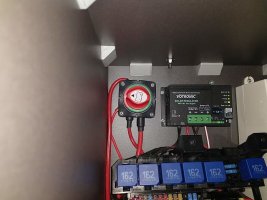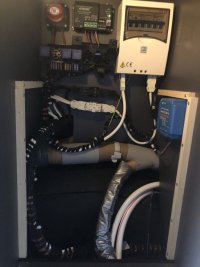Eber123
Lifetime VIP Member
Hello,
In many foren it is mentioned that users are not entirely happy with the battery capacity of the Grand California. 46 Ah useable electricity during an autumn, winter or spring weekend might be not enough.
Reading it up it seems that there are a few different groups 1.) happy with the existing battery capacity (or at least accept it), 2.) users wishing to install a Licitum battery, 3.) users try to connect an portable battery.
In "Caliboard.de" I found a post which explains to add a 2nd AGM battery. Advantages are:
Advantage:
Disadvantage:
I am not sure if I am allowed to point to the webpage with the information, but I do it anyway (@admins if there is a problem just take it out):
 www.caliboard.de
www.caliboard.de
Also as you can (will) see the information is in German, but I am sure Google Translate can help.
Let me repeat, I am not a electric specialist. So, I don't know if this is a good way to address the battery capacity of the Grand California, but to me it looks good. After my LPG is installed I will load up my camper for "long distance" traveling and will weigh it to see if I run into weight problems. If not I will talk to the company who installed the LPG system what they think about this.
What do you think?
Kind regards,
Eberhard
In many foren it is mentioned that users are not entirely happy with the battery capacity of the Grand California. 46 Ah useable electricity during an autumn, winter or spring weekend might be not enough.
Reading it up it seems that there are a few different groups 1.) happy with the existing battery capacity (or at least accept it), 2.) users wishing to install a Licitum battery, 3.) users try to connect an portable battery.
In "Caliboard.de" I found a post which explains to add a 2nd AGM battery. Advantages are:
Advantage:
- Minimal change of VW setup (warranty)
- Using all existing electric VW components
- Enough battery capacity for a (cooler) weekend
- Low cost
Disadvantage:
- More weight
- Camper Unit does not show everything correct (but this can be addressed)
I am not sure if I am allowed to point to the webpage with the information, but I do it anyway (@admins if there is a problem just take it out):
Verdopplung der Batteriekapazität im GC - Sparlösung / Einbau einer 2. AGM-Batterie im Stauschrank
Der GC hat insbesondere im Winter zu wenig Batteriekapazität an Bord. Die im Motorraum verbaute 92 Ah-Batterie sollte maximal zur Hälfte entladen werden, hat also eine nutzbare Kapazität von 46 Ah. Kühlschrank und Dieselheizung verbrauchen als Daumenwert im Mittel ca. jeweils 1A die Stunde, d.h. ...
Also as you can (will) see the information is in German, but I am sure Google Translate can help.
Let me repeat, I am not a electric specialist. So, I don't know if this is a good way to address the battery capacity of the Grand California, but to me it looks good. After my LPG is installed I will load up my camper for "long distance" traveling and will weigh it to see if I run into weight problems. If not I will talk to the company who installed the LPG system what they think about this.
What do you think?
Kind regards,
Eberhard
Last edited:




















